The least path of resistance, MFA thesis show
The works in “The least path of resistance” focused in on the idea of physical space in the urban environment, and its accessibility. I explored the concept of property in relationship to government and the human body, as well as metaphysical notions such as portals and their connections to physical spaces. I also examined the potential for transformation that destruction or alteration of an object can create, often creating something more impactful. Finally, other works in the show investigated the sacred objects that I see existing in pop culture such as the hoodie and a street sign from the urban environment.
In the universe I created, I envisioned myself as a shaman, whose vision is shaped by countercultures such as street art and pop culture. Exploring what I recognized as "the sacred," I forged a deeper connection by investing in what may have appeared mundane to an outsider. The cityscape served as a playground for exploration, presenting objects that direct and navigate our energies. Isolating and manipulating these objects beyond their purpose enabled me to create a new and magical meaning. As I suspended these objects in motion, in my sculptures and drawings they interacted and pushed against each other’s forms.
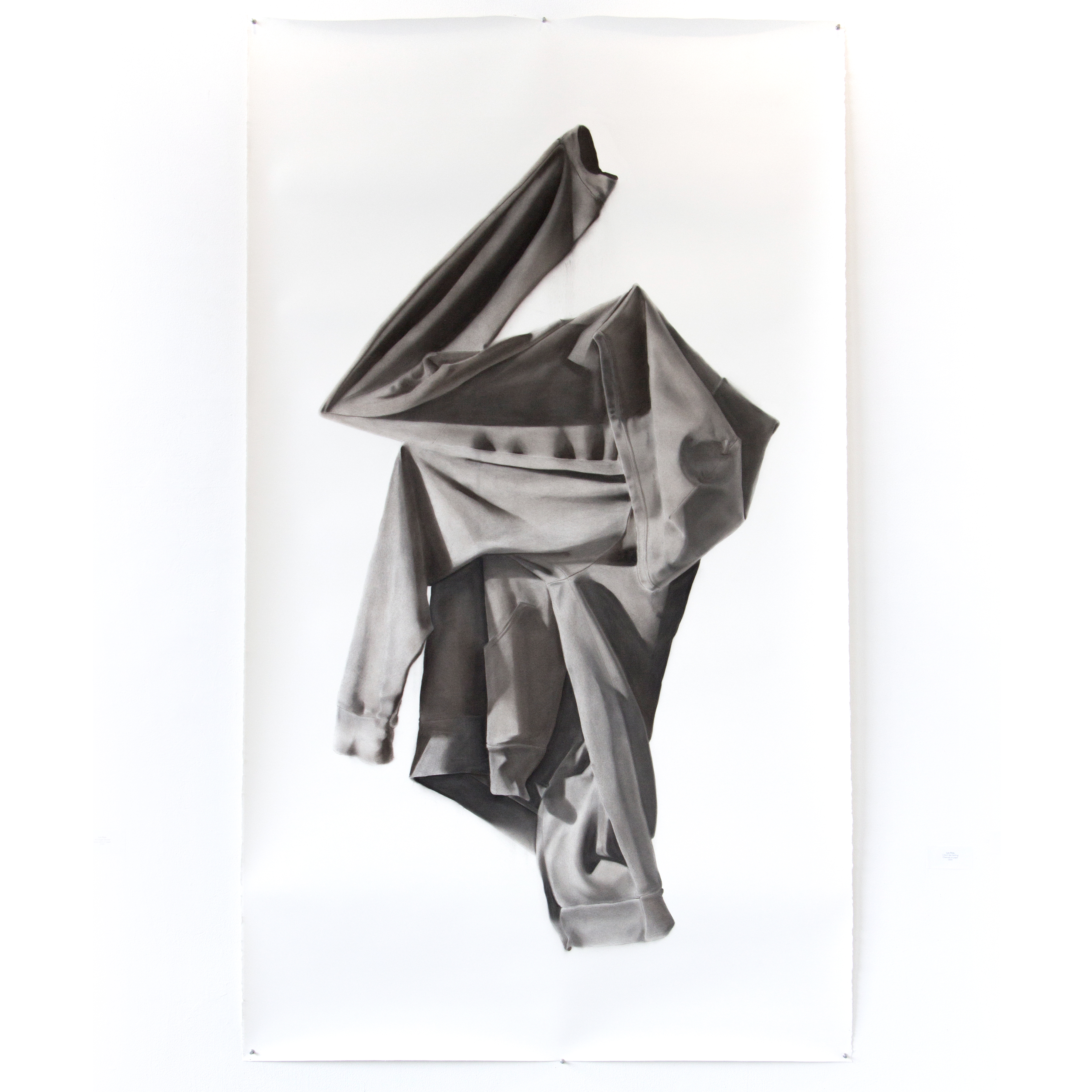
“I dont see nothing”
Charcoal on paper
51 x 96”
2015
Charcoal on paper
51 x 96”
2015
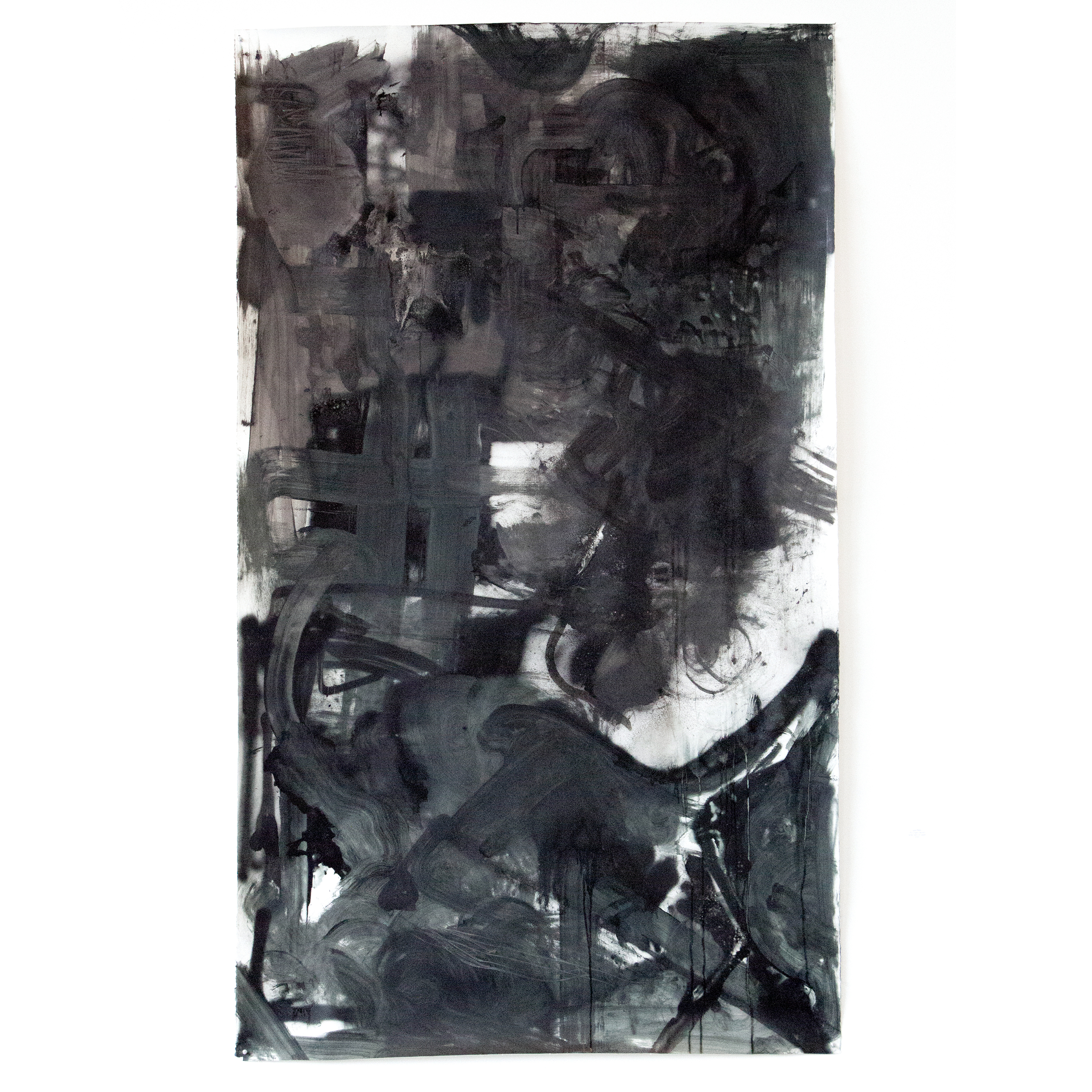
“no longer desired”
Spray paint and solvents on paper
51 x 96”
2015
Spray paint and solvents on paper
51 x 96”
2015
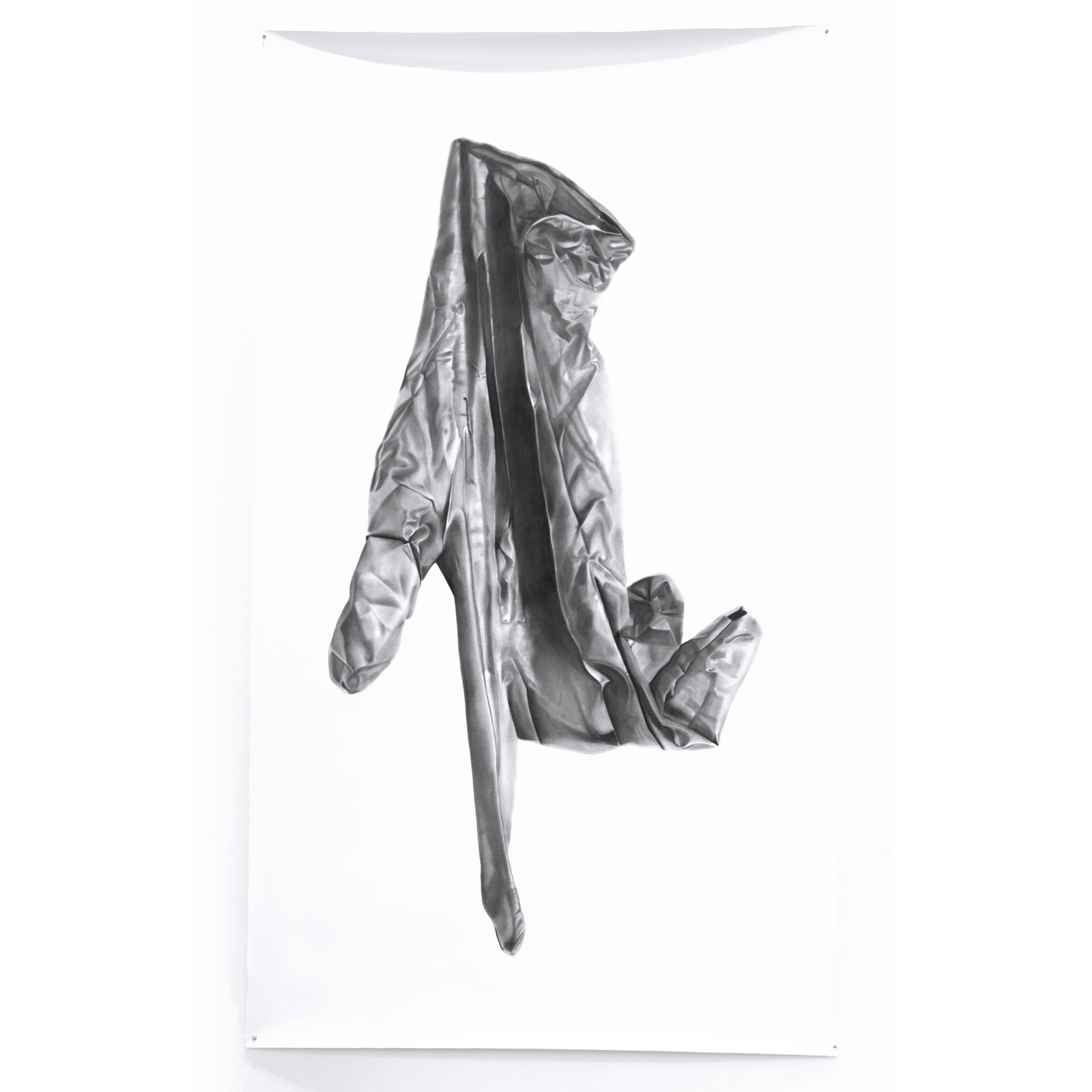
“Far away from blame”
Charcoal on paper
51 x 96”
2015
Charcoal on paper
51 x 96”
2015
I was exploring the multiple meanings behind the hoodie in my work at grad school. Through my performance art, I examined its ritualistic purpose as a guise and mask; likening it to a second skin. My drawings and sculptures of the hoodie focused on its significance and sacredness within contemporary and underground youth cultures such as punk, metal, metal, and hip hop, as well as its sociopolitical implications in social profiling, protests, and luxury fashion. The object in the drawing is presented in a suspended, contorted position. Influenced by David Hammons and motivated by the slaying of George Floyd a few years earlier, the work's title, "I don't see nothing," is a play on words that unconventionally highlights the importance of seeing everything - the magic, the spirit, the lies, and the pain - that are reflected in the bodies of Black, Indigenous, and people of color.
“No longer desired" speaks to the need to let go of a process and allow the work to take its own course, as well as our tendency to discard the broken, damaged, and battered things in our lives without recognizing their potential for transformation. I continued to explore the concept and process of using solvents to create and erase paintings with spray paint in many of my later works. I believe I am pushing the boundaries of destruction and erasure, making marks with spray paint and then using my hands and sponges to manipulate the paint with solvent. By changing the marks, I seek to both obscure the original intentions of the piece and to amplify the idea of destruction and renewal. By working in the principles of creation, destruction, and erasure, I have created new works that explore the concepts of absence and presence.
“Far Away from Blame” continues to examine my ideas of the sacred. By placing the objects in a larger-than-life realm, their subcultural importance is highlighted and reinforced. The phrase itself speaks to a sense of liberation from those laws that govern us, encouraging a sense of anonymity and personal freedom. This work speaks to the notion of duality and the complexity of an individual’s identity within the larger scope of social and political systems. The object becomes a representation of this idea by entering a state of suspended animation, signifying a reality apart from the common experience.
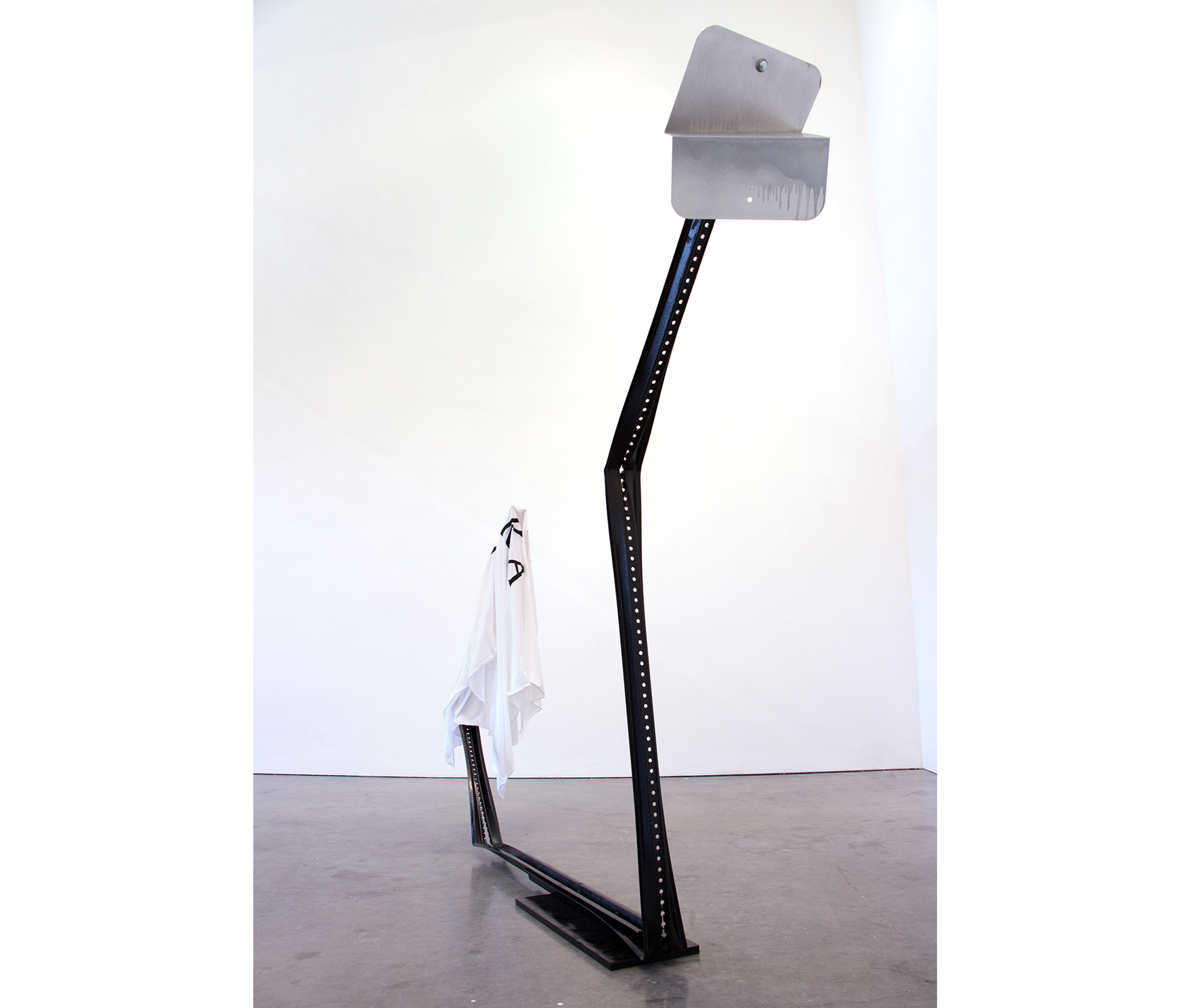
“Acamani (front view)”Screen print on fabric, steel pole, spray paint, aluminum sign, steel base
72 x 24 x 48”
2015
72 x 24 x 48”
2015

“Acamani (side view)”Screen print on fabric, steel pole, spray paint, aluminum sign, steel base
72 x 24 x 48”
2015
72 x 24 x 48”
2015
In "Acamani," I explore the spiritual power or energy in the objects of the urban landscape. Acamani is a Quechua name for a mountain, home to magicians called the Kollahuayas. This piece repurposes an earlier work in which I silk-screened Quechua words onto fabric to create flags, masks, and props. The fabric is inscribed with the word Wilka, which means both "holy" and "dangerous," an indication of the all-encompassing power of the sacred in Quechua culture. In my art practice, I perceive articles of clothing and fabric as bearers of energy, possessing their own histories and stories, just as our souls do. The street sign itself embodies an energy in its form, as if in a state of suspended animation. By using street signs and fabric in my work I am calling attention to the mundane. The work becomes a messenger, calling us to find the sacred within us. In these works I encourage us to find strength, beauty, and magic in the every day, to see our urban environment as an opportunity to build our own version of an Andean mountain: a spiritual center to which we can always return.

“In complete disagreement”
Fabric, resin, steel pole, acrylic, aluminum sign, wood base
48 x 32 x 72”
2015![]()
“In complete disagreement (detail)”
Fabric, resin, steel pole, acrilic, aluminum sign, wood base
48 x 32 x 72”
2015
Fabric, resin, steel pole, acrylic, aluminum sign, wood base
48 x 32 x 72”
2015

“In complete disagreement (detail)”
Fabric, resin, steel pole, acrilic, aluminum sign, wood base
48 x 32 x 72”
2015
In this body of work I was able to make connections between ideas (what is sacred) and things (inanimate objects). I looked at these objects as the Shaman and was able to see energy in the mundane. By isolating and manipulating the objects in this piece, I created a state of abstracted suspension that extends beyond their purpose. I allowed the objects to create a new language. In a suspended state of motion, the two objects (the fabric and the sign) interact with each other. Both pushing against each other’s form.
The title “In complete disagreement” is another play on words about the disagreement of both energies and the unfinished collision of the objects. Having these objects in a state of suspended motion creates a sense of illusion or magic for me. However mundane the objects can be whether the pole was part of an accident and the fabric is being blown against the sign by the wind or if they were manipulated to exist by some other force is what I allow the viewer to walk away with.
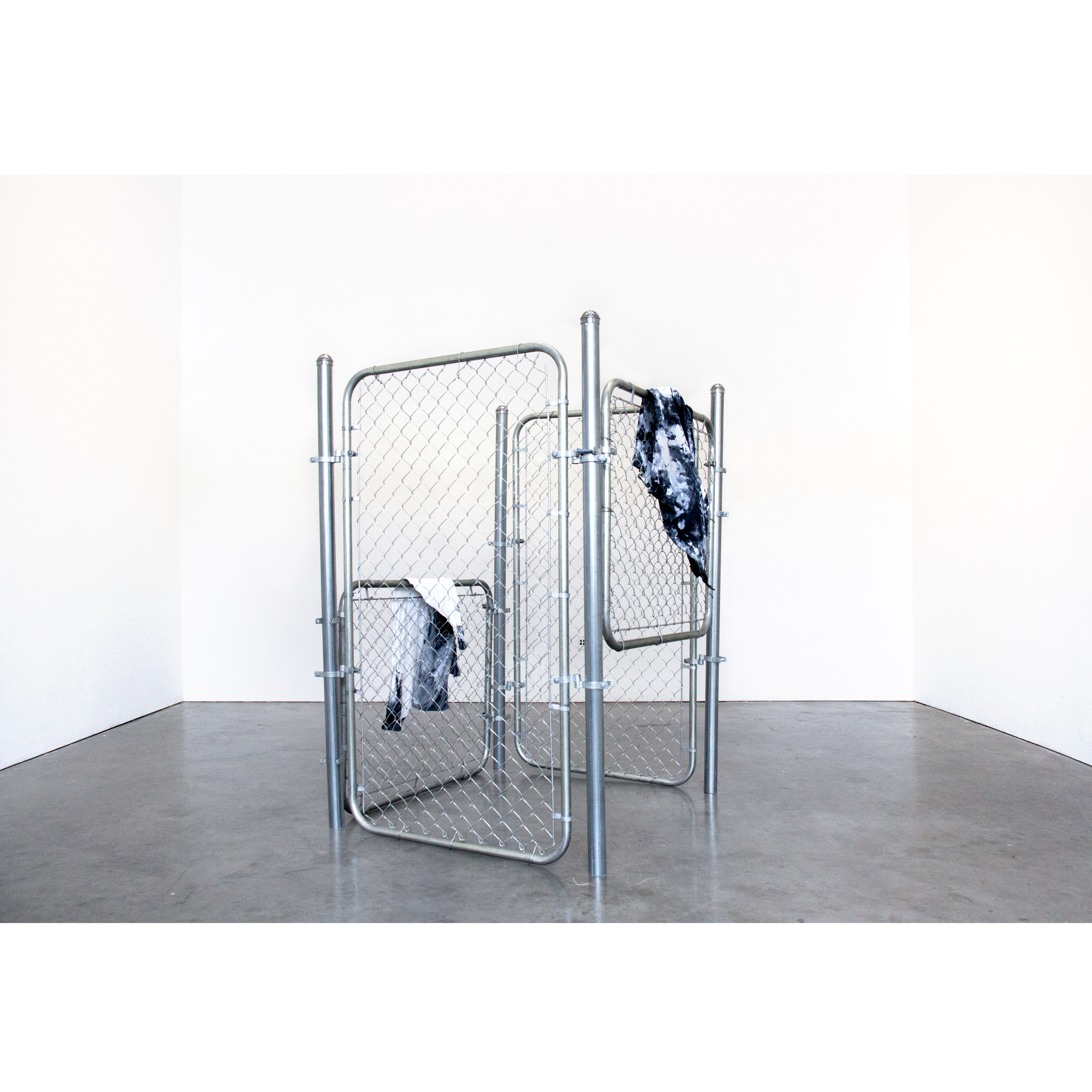
“Grid of intelligibility”
Fabric, acrylic, fencing
48 x 48 x 72”
2015
Fabric, acrylic, fencing
48 x 48 x 72”
2015
Exploring the chain-link fence as a medium gave me an interest in the way people move through public spaces. The fence's versatility makes it a useful tool in a wide range of applications, from private and public safety to defining areas of land and providing direction for travelers. When creating "Grid of Intelligibility", I wanted to explore the tension between restricted and open access in terms of public and personal space. To do so, I constructed a cage with two entry points - one that is difficult to access, and one that provides an easy entry. Accompanying these entry points are t-shirts, familiar items I would see clung lifeless to fences around the city. They represent lost instances, like trapped ghosts with no way in or out of their entanglement.

“An opening that can be closed with a lack of deep admiration (installation view)
”
Painting, performance, installation.
Ink, spray paint on drywall, galvanized fence/ steel, cleaning solvent
48 x 252 x 84”
Performance 00:02:00”
2015
”
Painting, performance, installation.
Ink, spray paint on drywall, galvanized fence/ steel, cleaning solvent
48 x 252 x 84”
Performance 00:02:00”
2015
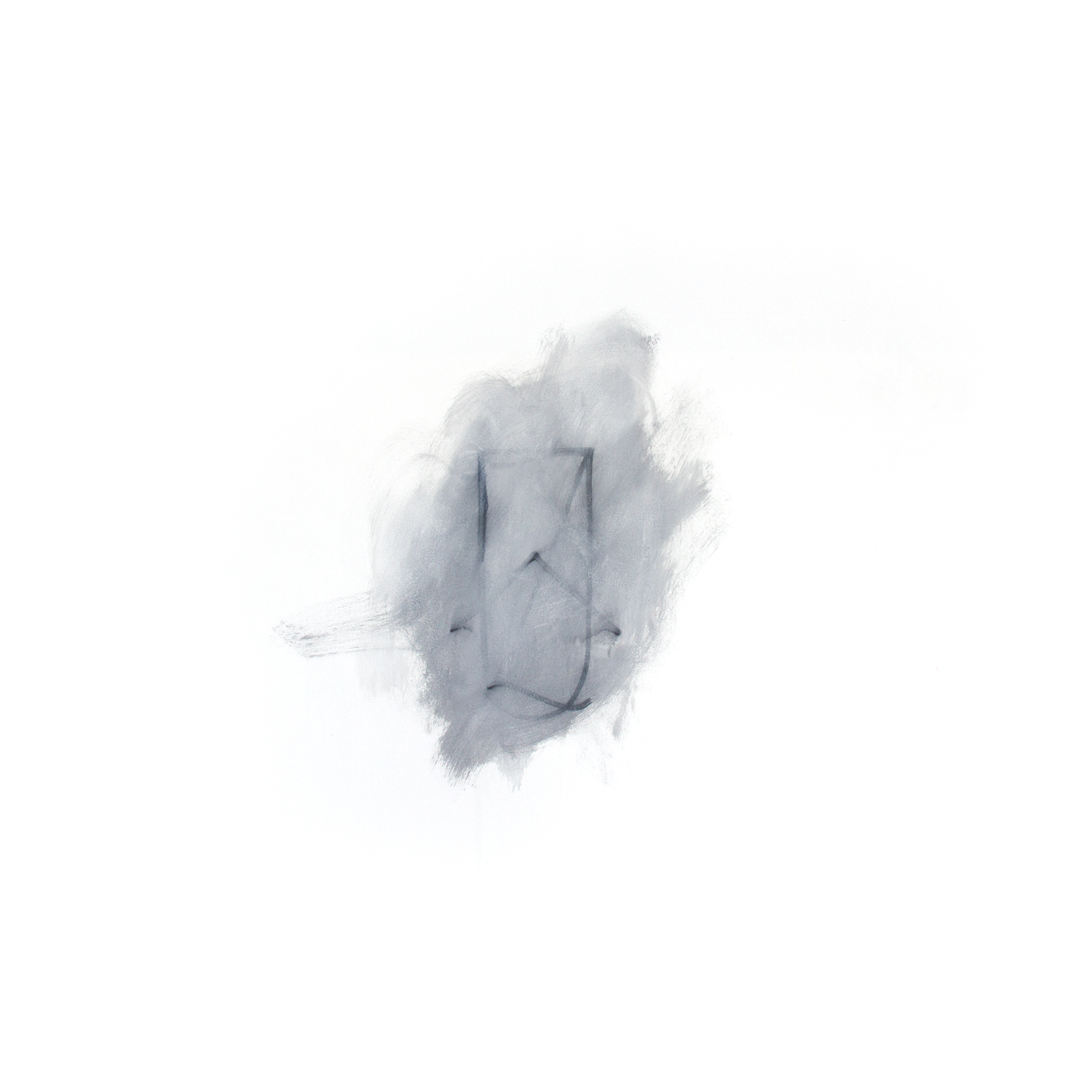
“formation I, Runa (after performance)”
Ink on drywall, cleaning solvent
2015
Ink on drywall, cleaning solvent
2015

“Formation I, Runa”
Ink on drywall
2015
Ink on drywall
2015
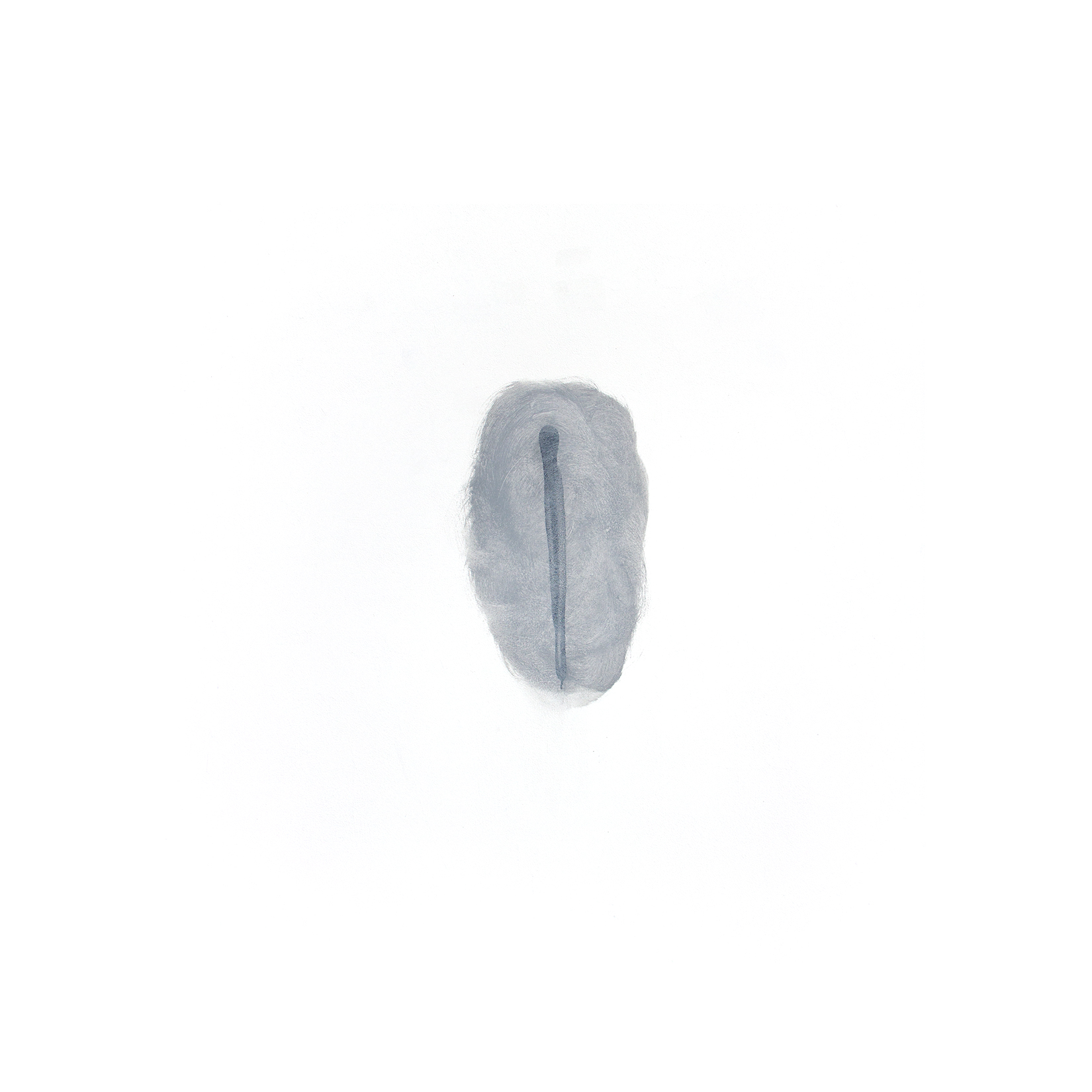
“Formation II (after performance)”
Spraypaint on drywall, cleaning solvent
2015
Spraypaint on drywall, cleaning solvent
2015
In the work “An opening that can be closed with a lack of deep admiration”, I investigated the concept of the fence as an object of obstruction that can both limit the voyager and enable passage as a portal. In this piece, the portal (hole in the fence) was created by an anonymous person who left two markings on the interior wall: The first marking on the left is “Formation II”, a monogram of the Quechua word RUNA meaning “person, or being”, and “Formation I”, a line, sliver or cut-like marking; another portal beyond the first. The performance itself took place on opening night and was a constructed scenario in which two anonymous individuals in white protective clothing entered the space and removed the two formations inside for 40 seconds. The end product was a combination of destruction and creation. Through the performance, I sought to highlight the duality of obstruction and access a fence can offer. I wanted to push the audience to explore and understand that defenses may have to be broken, in order to gain access to new and unknown spaces.
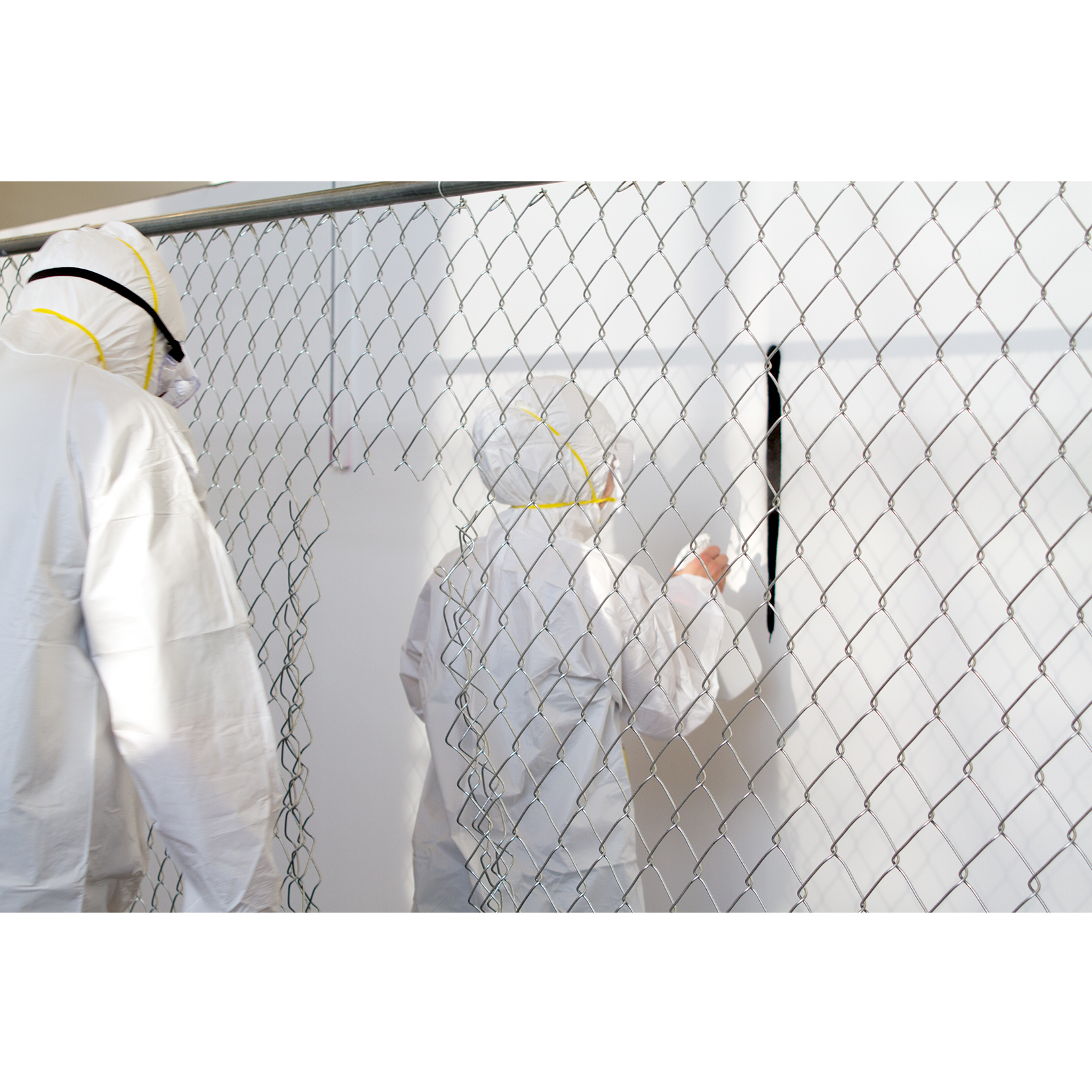
“An opening that can be closed with a lack of deep admiration (performance still)”
Spraypaint on drywall, cleaning solvent
2015
Spraypaint on drywall, cleaning solvent
2015
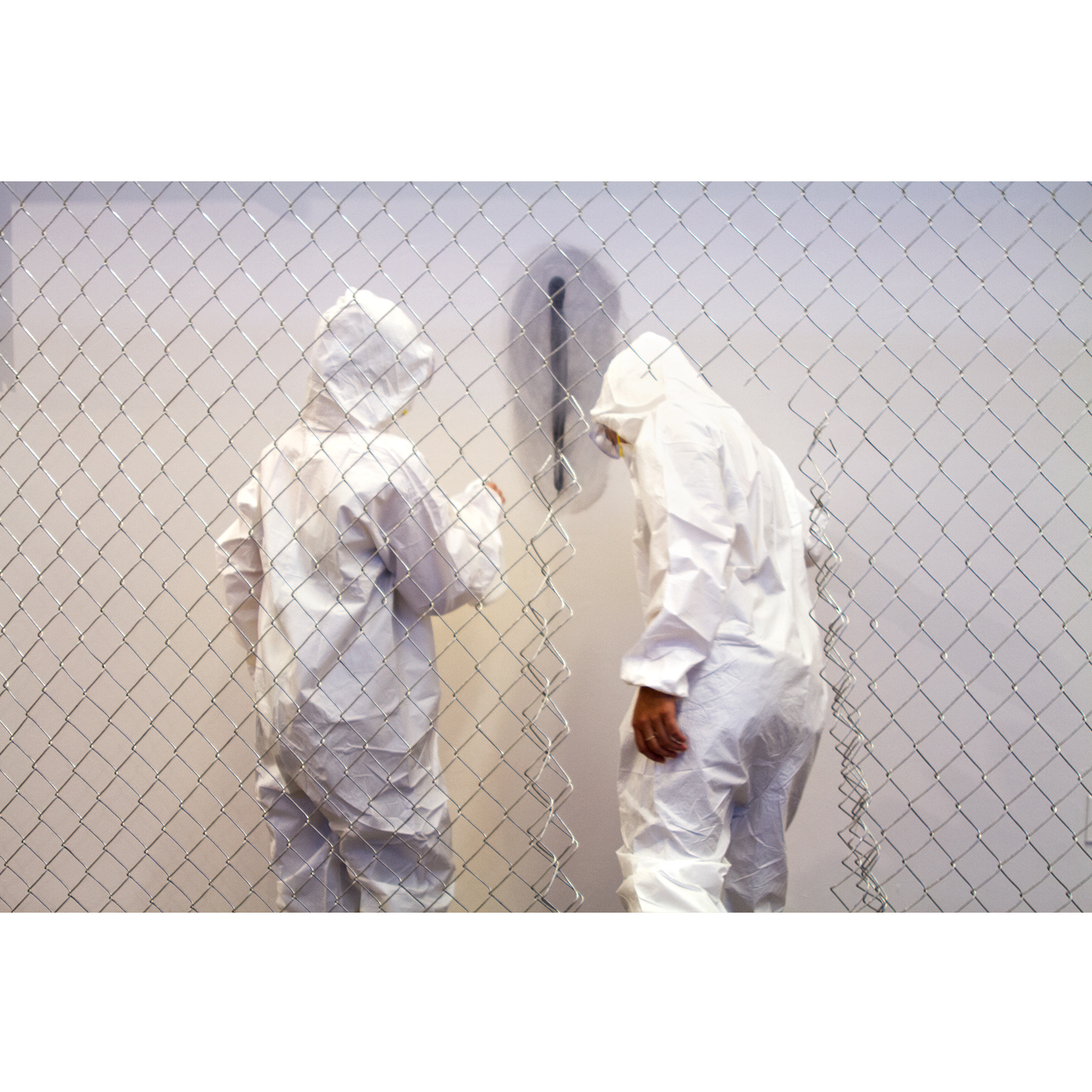
An opening that can be closed with a lack of deep admiration (performance still)“
Spraypaint on drywall
2015
Spraypaint on drywall
2015

An opening that can be closed with a lack of deep admiration (performance still)“
2015
2015
“The least path of resistance (installation view)”
Mixed media
Sizes variable
2015